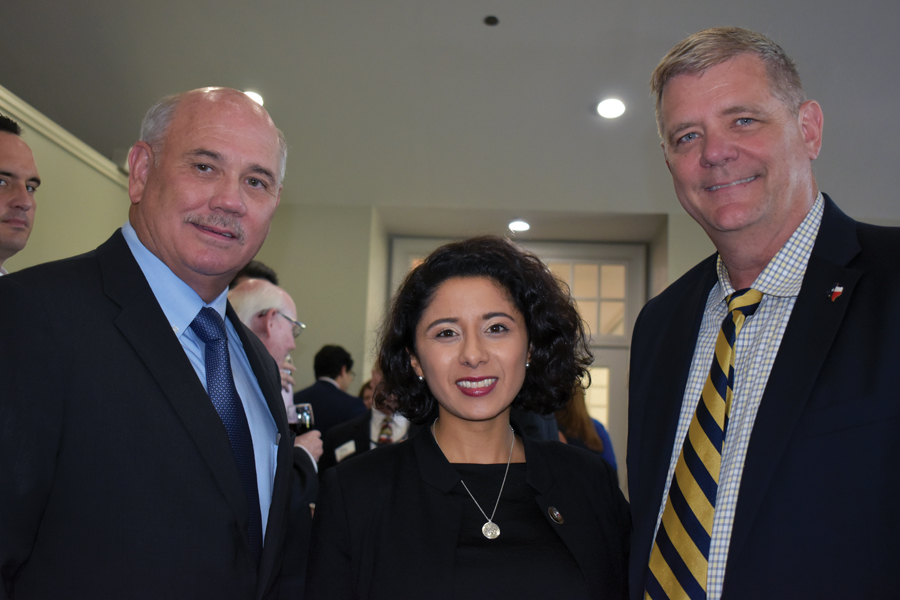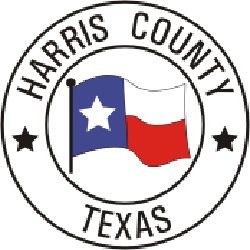
Harris County Commissioner Jack Morman, center, gets a warm welcome from Space Center Rotary President Ralph Kramer and Program Chairman Kippy Caraway as he arrives to address the club during its luncheon meeting at Bay Oaks Country Club. Photo by Mary Alys Cherry
By Mary Alys Cherry
This past year Harris County was on the receiving end of one of the worst flooding events in our nation’s history,” Harris County Commissioner Jack Morman told members of Space Center Rotary.
Speaking at their luncheon at Bay Oaks Country Club in Clear Lake, the Precinct 2 commissioner updated the crowd on Hurricane Harvey, which nearly drowned Harris County with more than 50 inches of rain in just 4 days.“That represents 70 percent of our average annual rainfall — 250 days of rain in 4 days.
“In unincorporated Harris County, over 30,000 residential structures flooded during Harvey, with approximately 5,700 homes flooded in Precinct 2. Everyone was affected in some way by the storm, but the resolve of the people of Harris County, both during the storm, and throughout the recovery process, has been inspiring to witness.”
After taking a moment to recognize Constable Phil Sandlin, his deputies and other law enforcement who helped save countless lives during the storm, the commissioner talked about the 260,000 cubic yards of debris picked up by Precinct 2 crews and contractors – “enough to fill 16,000 dump trucks” — and the severe damage to the Lynchburg Ferry landings, noting that the ferry finally resumed service March 3.
GREATEST CHALLENGE
“Fixing flooding issues in our area will be this generation of leaders’ and lawmakers’ greatest challenge. We have been working on ways, not only to recover from the storm, but to better protect Harris County residents from future flooding. In December, Commissioners Court voted to update the floodplain regulations for the unincorporated areas of Harris County. The City of Houston is still discussing their proposal.”
This will mean changes to building height requirements, stricter permitting on buildings within the 100 and 500 year floodplain, and guidelines for mapping the floodplains. “In the past, building officials have focused on the 100 year flood event. Clearly they were off the mark. We now are basing much of this new criteria off of the 500-year flood plain. Harris County Commissioners Court has approved $20 million, in what we hope is only the first phase of funding for home buyouts,” he said, going into some detail about the buyouts.
“We are still waiting on money from the Federal relief package. So far, Flood Control has proposed to Congress over $10 billion in projects and efforts addressing flood risks in the county. Large scale projects, like the coastal barrier, and the possibility of another large reservoir in Northwest Harris County, are dependent on the funds we receive from the relief packages.”
BOND REFERENDUM
Waiting on the Feds, he continued, “can’t be our only option, in the meantime we need to create effective flood protection infrastructure. Later this year, the county will propose a flood control bond referendum to the voters to jumpstart flood control infrastructure building. This money will let the Flood Control District make immediate improvements to our flood control infrastructure, such as channel widening, storm water detention basins, and more efficient floodwater conveyance.
“While we wait, the flood control district is working on solutions right now. There are several . . . tributaries of Horsepen Bayou that are scheduled for channel restoration and desilting. The channels . . . located along Bay Oaks, Oak Brook and Bay Forest subdivisions are scheduled to go to construction in summer of 2018.”
Along with these channel repairs, there will be major conveyance improvements to Armand Bayou between Beltway 8 and Spencer Highway…to account for the expansion of the Belt and solve existing drainage issues, he added. “These two projects will greatly reduce the risk of flooding in the area . . . similar to what our friends at the Clear Lake Water Authority have done with Exploration Green—which, by the way, we believe saved hundreds of homes from flooding during Harvey.

 The Houston-Galveston Area Council has announced the launch of the Gulf Coast Regional Tow and GoT Program, which provides no-cost towing for vehicles that break down from mechanical failure while traveling within the City of Houston on freeways with camera coverage.
The Houston-Galveston Area Council has announced the launch of the Gulf Coast Regional Tow and GoT Program, which provides no-cost towing for vehicles that break down from mechanical failure while traveling within the City of Houston on freeways with camera coverage. Harris County Commissioners Court voted June 12 to place a $2.5 billion bond proposal on the
Harris County Commissioners Court voted June 12 to place a $2.5 billion bond proposal on the 
 Harris County Commissioners Court unanimously has approved a set of property tax exemptions that will virtually eliminate county property tax bills for thousands of older or disabled homeowners here and greatly reduce tax bills for nearly everyone else.
Harris County Commissioners Court unanimously has approved a set of property tax exemptions that will virtually eliminate county property tax bills for thousands of older or disabled homeowners here and greatly reduce tax bills for nearly everyone else.

